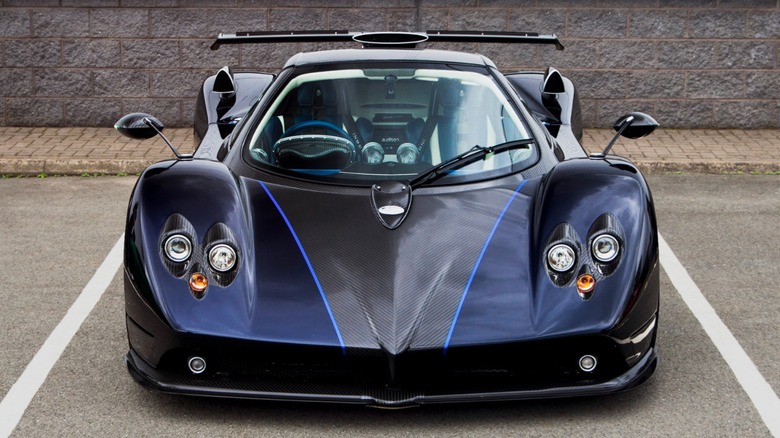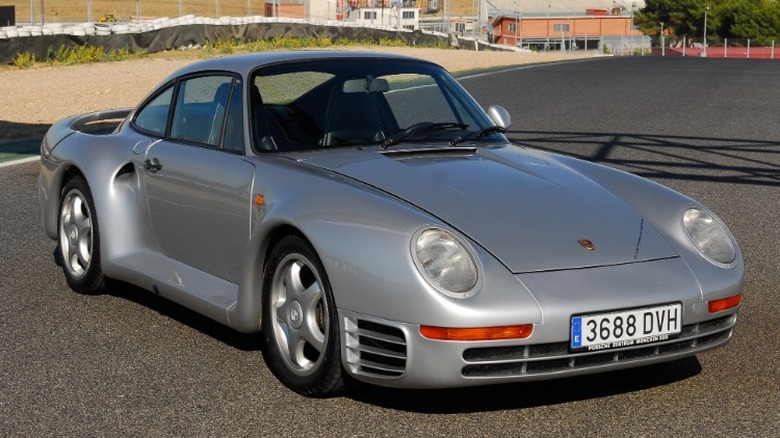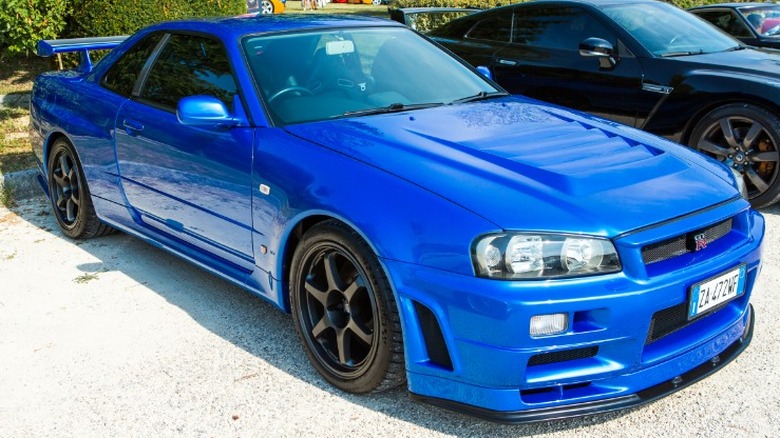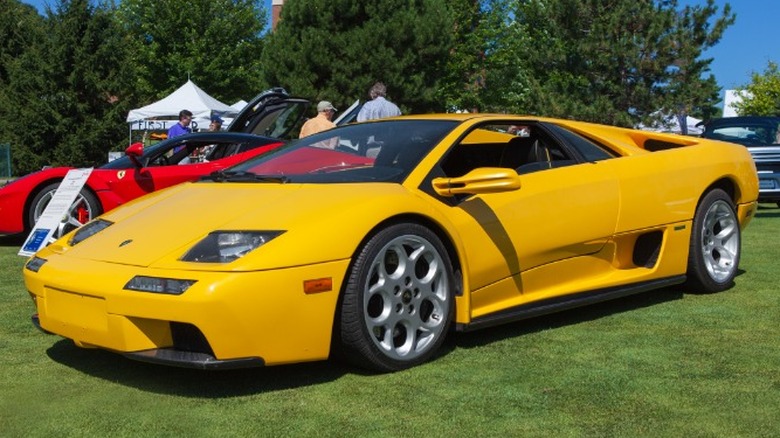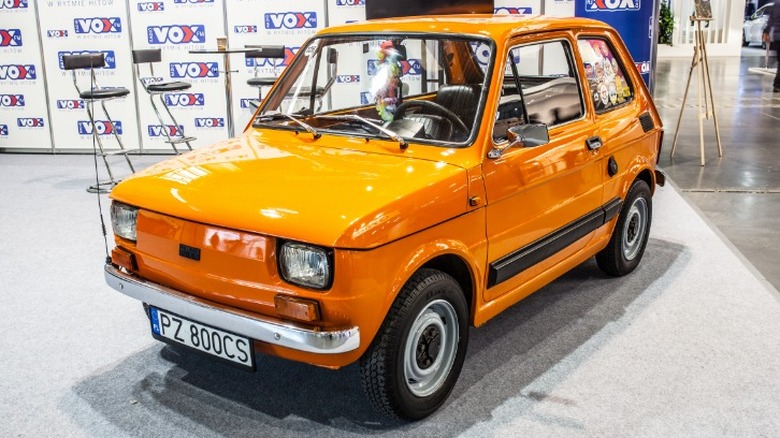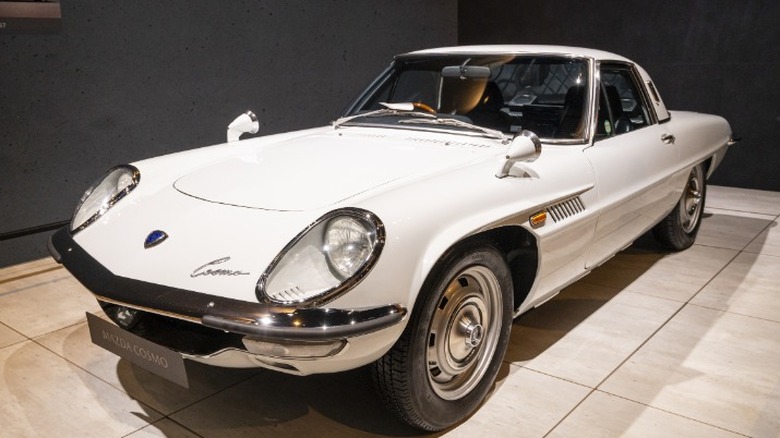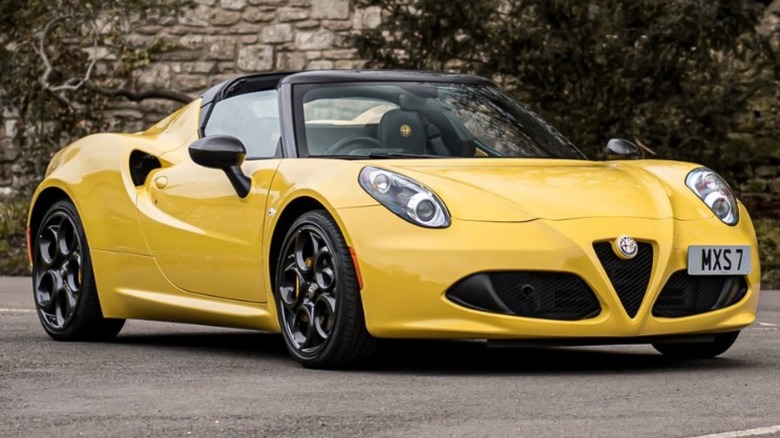12 Beloved Cars That Are Actually Banned In The USA
European auto manufacturers have built many desirable motorcars that Americans may never get to drive. Regulations governing the manufacturing requirements for safety and environmental concerns differ from one country to another, making it necessary to alter a car's design to conform to those rules. Occasionally when the Europeans or Japanese create exclusive future classics, the trouble of creating versions to conform to U.S. regulations is just not worth the effort. Therefore, many never leave their home continent.
The inability to legally import cars does not only apply to limited production exclusive cars built for those with the means to purchase them. Many models are sold only in the home market because they are poorly suited to American driving habits and tastes, causing some manufacturers to only market a few vehicles for overseas export. There is one loophole when discussing imported vehicles not made to conform to American regulations, and that is the time limit. According to Autoweek, a law introduced in 1988 banned the importation of any car less than 25 years old without going through a rigorous and expensive process to certify them for use on public roads. So, with all that in mind, here are a dozen cars beloved by American auto enthusiasts that are (or once were) banned in the U.S.
Porsche 959
Ask any car enthusiast with a penchant for Euro power what is the most advanced supercar of the '80s, and the answer is likely the Porsche 959. Created to run in the ill-fated Group B racing series, the Porsche 959 was the most technologically advanced car of its day. According to Stutt Cars, it integrated the digital age fully into the automobile with computers controlling the engine, turbos, suspension, and traction control. The advanced componentry and lightweight materials used to construct it made it very expensive and only those with substantial wealth could afford one, if they were European.
With such an audacious project as this, news about the incredible machine circulated globally and piqued the interest of some wealthy Americans interested in buying one, such as Bill Gates, founder of Microsoft. Attempts to import the car were thwarted by then-new import regulations and Porsche had no desire to make it pass U.S. regulations as that would have required crash testing 120 vehicles, an enormous expense for the sale of a handful of vehicles.
Undaunted by the hurdle, some intrepid enthusiasts, according to Road and Track, worked diligently to find a way to get the cars into port. Their efforts resulted in a new law known as Show or Display, which allows certain cars of particular significance and limited production to be imported but not be driven more than 2,500 miles annually. And that is how Bill Gates and a few others got their hands on the ultimate Porsche.
Nissan Skyline R34 GT-R
Nissan has produced a Skyline model since the late '50s, first as a Prince model and renamed to Nissan shortly after introduction. Its styling modeled American designs and it was intended as a luxury model, according to Motor 1. The car continued through the '60s as just another Nissan until 1969 when the first performance-oriented GT-R model was introduced with a 160 horsepower inline-6 engine. The GT-R grew into somewhat of a legend, but never once did one arrive in the Port of Los Angeles with the steering wheel on the left.
The R34 Skyline produced from 1999 to 2002 shot up in popularity from its inclusion in the Gran Turismo video game and its inclusion in the popular Fast and Furious movies. However, R34 cars are only becoming eligible in 2024, which will likely see a flood of them imported from Japan at a premium. Hagerty says the two previous generations of Skyline have been popular with importers but their popularity may have peaked, especially since interested buyers now only have to wait a short time to acquire the most desirable model. Regardless of which one is legal to import and when, none were ever made with left-hand drive, so all of them should be interesting to drive in North American traffic.
Volkswagen Type 1 Beetle
The VW Type 1 "Beetle" was one of the best-selling cars in the U.S. for decades until it was pulled from the market in 1977. One may wonder why this car is on the list as there are still thousands around to choose from. Although the Beetle left the U.S. in the '70s, it continued production in Mexico until 2004.
While most of the car remained unchanged, it did receive updates, including modernized interiors and improvements to the engine, although it had already received electronic fuel injection for its last year in the U.S., according to Curbside Classic. Today, classic Beetles are rising in price. With 46 years having passed since the last one entered the country legally, some enthusiasts may opt for one from Mexico built in 1997 instead. By the time production ended, Beetles offered better fabric upholstery, a stereo sound system with four speakers, a security alarm, and modern halogen headlights. Those who import a legal Mexican Beetle can have the classic looks of the car with a few of the modern conveniences, however, it will still be a few more years before the final 2004 Última Edición is legal to cross the Rio Grande.
Jaguar XJ220
Jaguar's ambitious supercar project started with the promise of a genuine Jag V12 but ended up with a twin-turbo V6. Jaguar had always been known for making sporting cars and race winners, but mid-engine supercars were never something associated with the brand. The plan to make a world-class supercar was gutsy and the result turned out to be one of the coolest cars of the '90s, the XJ220.
The XJ220 started as a side project among a few Jaguar engineers who received no official support from the company. By working weekends and calling in favors from suppliers, a production eventually became ready to be built by Jaguar having the lofty goal of breaking 200 mph. Even though the V12 never materialized, much to the chagrin of some who had placed deposits, the twin-turbo V6 managed an impressive 540 horsepower and the final design of the car was striking (via Garage Dreams). Only 281 examples were produced as turmoil in financial markets killed sales and the program was scuttled.
With so few copies made, it would be impossible to make sense of spending the money to have it tested for U.S. certification. The only examples that were imported came under the Show and Display scheme, which has since expired now that 25 years have passed and these gems can be driven anywhere.
Lamborghini Diablo Strosek
The Lamborghini Diablo is one of the great historical models from the Sant'Agata Bolognese company, and Americans had no trouble purchasing one brand new from the dealer throughout the '90s. But much like the original AMG company that modified brand new Mercedes models for sale, so did at least one custom performance company in Germany. Vittorio Strosek has been working in auto design since the '70s and often works with manufacturers with new car designs and in creating special editions. His company also does custom variations of select vehicles, including the Diablo.
The Strosek Diablo is a unique machine with some clever changes to the styling that make it distinct from anything else. The usual headlights have been replaced with small dual headlamps with streamlined housings, rounded bumpers that softened the look, and a modified spoiler. The cars also had unique paint colors applied to them and were finished off with a pair of peculiar side view mirrors mounted high on the window frame, which made the car unique and distinctive, setting it off from any other model immediately. However, these headlights and mirrors did not fall within the U.S. guidelines, and nothing could be done to make the car legal for export short of putting everything back to the way it left the factory. Some of these are now legal to import, but those modified after 1998 still have a couple of years to wait.
Fiat 126P
Fiat cars traverse roads all over the world. One of the ways the company has expanded its footprint over the years was by licensing its products to be manufactured in other countries, finding success with partnerships behind the Iron Curtain. Models of Fiat cars were once made in Yugoslavia, the Soviet Union, and Poland.
One of Fiat's most successful cars of the '70s was the 126 model. It was also produced in Poland where it was also known as the Polski Fiat 126P. Due to the planned economic policy of Communist Poland, the 126P was one of the only cars the public could buy, and it became very popular for those fortunate enough to have the privilege of buying one in the first place. Although popular in Eastern Europe, it never made it overseas as the American government was not prone to allow business with Warsaw Pact countries and its little 2-stroke engine would surely have failed emissions testing.
At least one 126P has a strong link to America. While filming in 2016, Tom Hanks posted a photograph with one of these cars and it made the rounds, ending up being seen by residents of the town where the car was made. A 1974 model was later restored and gifted to Hanks by the town of Biesko-Biala, which he graciously accepted (via Secret Classics). Hanks eventually put the car, which he had signed on the left door panel, up for charity.
BMW M3 Sport Evolution III
In the '80s, BMW got serious about offering performance to its customers with modified versions of its regular production models. The resulting vehicles became models such as the M3 and M5. These faster sport-tuned varieties became an instant success with buyers clamoring to get a new BMW sports sedan in their garage.
While early M3s may be legends themselves, BMW turned it up to 11 with the model in 1990, creating the M3 Sport Evolution III. According to Road and Track, BMW needed the production of 5,000 cars to satisfy homologation rules to race in Group A but also subsequently needed a bona fide race car to put on the track. This would be the Evo III, which shares no body panels except the hood. It also features a larger 2.5-liter engine with various performance enhancements including a hotter cam, larger valves, and free-flowing exhaust. Coupled with the more powerful engine were electronically controlled suspension, 18-inch wheels, and body elements to increase downforce, including an adjustable spoiler.
In the end, 600 copies were made. None of them were exported to the U.S. because this was made to satisfy racing regulations and export variants were not a consideration. As a result, it would not have passed certification if that had even been tried. Today the value of these cars is astronomical with one selling on Bring a Trailer in 2021 for an astonishing $245,556.
Mazda Cosmo
Japanese automaker Mazda is the only company remaining to have successfully produced and marketed Wankel rotary engines. Its popular RX-7 and RX-8 sports cars were available at dealerships until the model was phased out in 2012. Mazda also exported in the '70s the RX-2 coupe and the REPU rotary-powered pickup. But, since the late '60s, the flagship rotary-powered car from Mazda has been the Cosmo.
Beginning in 1967, Mazda built the new Cosmo sports car as a way to introduce its new rotary engine to the public. They were initially all hand-built in a special workshop and given the utmost attention and care. These early Cosmos were sold only in Japan and production was limited (via Silodrome). The Cosmo name was used for a couple of other models through the years, but it was the upscale luxury brand from Mazda that wore it best. The Eunos Cosmo of 1990 to 1996 would be the last, but it was powered by a unique 3-rotor 2.0-liter engine fitted with two sequential turbochargers that produced 300 horsepower.
This Cosmo was also an elegant and luxurious model featuring the latest in automotive conveniences and electronics throughout. The final Cosmo was only sold in the Japanese market for a premium price. It is still the most unique Mazda ever developed and has only recently been allowed to be imported by eager Mazda enthusiasts.
[Featured image by NAParish via Wikimedia Commons | Cropped and scaled | CC BY 2.0]
Rover Mini
When the British Motor Company released the first Mini in 1959, it created a legend. The now iconic little car is a permanent part of pop culture and has also become a British icon, as recognizable as the Queen herself. The Mini came along at just the right time and with the right formula to be a success, and that success endured for many decades.
The original Mini came from Austin and Morris dealers and it came with a 35 horsepower 1,200cc engine that used a novel transverse front-drive alignment with the transmission and engine sharing the same oil, an idea later utilized by Lamborghini with the Miura. Although the car was tiny, people were surprised by how roomy it felt inside and buyers flocked to the diminutive little auto. Sales in the U.S. began in 1960 and continued until 1967. While weekend racers found the cars to be excellent packages to put on the track, the size was not well suited for American highways (via Moss Motoring).
Although sales ended in the U.S., the Mini continued in production for decades. Ownership changed hands until production was managed by Rover. The Mini may have had some upgrades, but it remained essentially the same, even after BMW bought Rover in 1994. Under German ownership, losses stacked up and production ended in 2000 when BMW announced a modern successor. These Minis were not certified for American roads and only as they hit the 25-year mark can they be brought over.
Alfa Romeo 8C Spider
Although Alfa Romeo has been making cars since the early 20th century, it has not always been sold in North America. As an Italian company, its bread and butter are smaller cars suited for driving in compact cities on streets originally carved in medieval times, and land barges are ill-suited in this environment. As a result of this, Alfa Romeo vehicles have never gained a strong foothold in the U.S., and the company fled the market in 1995, per Autoblog. But the hiatus would not last long as the company re-entered the market with its supercar-like 8C Competizione in 2008. This car was more of a soft return as total production was just 500 units, of which only around 100 were slated for the American market.
Although a new Alfa was sold in the U.S. for the first time in more than a decade, we would only see the hardtop. At some point, the powers that be determined that the convertible version of the 8C was not built to satisfy NHTSA safety regulations, denying legal imports of the car. However, in 2016, the agency backtracked on this decision, announcing in the official federal register that the Spider is substantially similar and is eligible for importation. Why it took eight years to decide a car conformed to regulations is anybody's guess, but it greatly reduced the usual 25-year limitation.
Porsche 964 Carrera RS
From its inception, Porsche has occasionally made special edition cars focused on speed over comfort. Porsche first adopted the Carerra moniker in 1973 as the company continued to push the envelope and squeeze more power out of its flat-6 air-cooled engines. Starting in 1991, Porsche began offering a stripped-down model built to optimize the power to gain performance and the car was dubbed Carrera RS (via Auto Evolution).
Power from the engine of this car was rated at 260 horsepower, but the additional weight savings is what pushed it over the top. The interior was as spartan as possible with no carpet, power windows or steering, air conditioning, stereo, or generally anything that was not needed to go fast. It was built as a genuine driver's car but it was also only built for Europeans. Porsche didn't think that the effort to have them certified for U.S. regulations would be worth the effort, so they all stayed in the Old World for at least the first 25 years. Road and Track says that Porsche did respond to Americans' desire for this car by releasing the RS America, but it was a watered-down version and remained heavier than its Euro counterpart. Now that 25 years have passed, these can be imported, but they are not the kind of car that typically goes down in value.
Pagani Zonda
Horacio Pagani is a bit of a supercar legend after having a big part in the later development of the Countach and a heavy hand in the development of the Diablo. However, being a visionary and identifying trends in the manufacture of carbon fiber, Pagani left Lamborghini to establish his own company, eventually presenting us with the Zonda, a masterpiece of automotive manufacturing.
The Zonda was built from 1999 until 2017, with a total of 140 cars produced. They all use a specially engineered Mercedes AMG V12 that puts out up to 760 horsepower. Each car is hand-crafted from carbon fiber and aluminum, with other lightweight materials to give the cars one of the best power-to-weight ratios possible. To get this level of craftsmanship and adrenaline-inducing speed, the cost is high with Zonda selling to customers for more than a million dollars at the low end (via Dyler).
For some, the Zonda is as good as it gets and represents automotive perfection. Few can afford the experience and only outside of the United States. Zondas have not been federalized for import and are only allowable under the Show and Display rule, per Ed Bolian, although Pagani's second car, the Huayra, is fully compliant with U.S. regulations.
